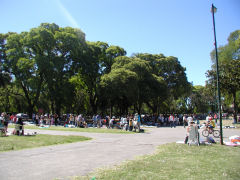 Buenos Aires – When I wander, I often like to wander without any particular aim. This has, once or twice, or perhaps more than that, landed me in some neighborhoods of the world that were, shall we say, less than savory. I’ve never ended up with a problem, though occasionally I find myself wondering just exactly why I don’t carry a guide book to give me some, well, guidance. It also means, that although I see things I otherwise might not have seen, I also miss things that I might have. And so, yesterday afternoon, whimsically hopping on the #118 bus, I shortly found myself in the heart of the “working class” barrio of Parque Patricios. Now, my goal was the park itself, as that showed prominently in the center of my map of the barrio. The bus dropped me off at its terminus, a dozen or so blocks from the park, an amble through a mixed industrial, warehouse, and, as stated, working class neighborhood. Initial trepidation at the somewhat deserted feel of the tree-lined but rundown streets dissipated as I walked and didn’t encounter anything but a few friendly waves.
Buenos Aires – When I wander, I often like to wander without any particular aim. This has, once or twice, or perhaps more than that, landed me in some neighborhoods of the world that were, shall we say, less than savory. I’ve never ended up with a problem, though occasionally I find myself wondering just exactly why I don’t carry a guide book to give me some, well, guidance. It also means, that although I see things I otherwise might not have seen, I also miss things that I might have. And so, yesterday afternoon, whimsically hopping on the #118 bus, I shortly found myself in the heart of the “working class” barrio of Parque Patricios. Now, my goal was the park itself, as that showed prominently in the center of my map of the barrio. The bus dropped me off at its terminus, a dozen or so blocks from the park, an amble through a mixed industrial, warehouse, and, as stated, working class neighborhood. Initial trepidation at the somewhat deserted feel of the tree-lined but rundown streets dissipated as I walked and didn’t encounter anything but a few friendly waves.
“In the beginning, around 1900, tango was danced between men, in the corners of any red-light district of Buenos Aires, in the patios of the old conventillos or in the old slaughter houses (mataderos) at the Patricios Park. At that time, the tango with women was only danced in the brothels or in the houses with “easy life” girls known as las casas de las chicas de vida ligera. Argentineans say that respectable women could not dance tango because it was a prohibited, it was a prostibularia dance, una danza prohibida. For them the tango did not exist.
Parque Patricios, like the rest of the world, underwent a transformation. It was rescued from a dubious past by city officials at the beginning of the 20th century. It was mainly the home of lower-middle class people, it used to house the meatpacking industry until the early 1900s. Eliminated were the main slaughterhouse, refuse piles, trash incinerators and the yellow fever cemetery. Immense parks, a zoo, hospitals and wider avenues took their place. The only monument to yellow fever victims is in front of the Infectious Disease hospital. The only in-city prison was in Villa Devoto. Today’s Parque Patricios is a vibrant, working-class district. Providing a contrast to the northern part of town, there are fewer high-rise apartments, glimpses of the industrial past and a neighborhood charm that some parts of the city have lost. Boedo and Nueva Pompeya are the most important tango neighborhoods in town, but Parque Patricios has seen its fair share of musicians & songwriters. Over 150 miniature houses wrap around two tiny plazas and tiny streets. The microbarrio of La Colonia is a lasting reminder of Perón’s legacy to provide each family with a place to call home.”
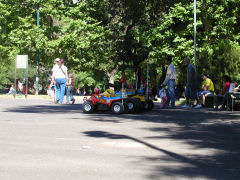 What I now know about the barrio comes primarily from brief blurbs on various blogs and the site devoted to tango quote above, but it’s enough to pique my interest, as I saw nothing really but the park itself. The microbarrio La Colonia of miniature houses created by Juan Perón sounds fascinating, and I look forward to wandering back there one day to check it out. The park itself is fairly large, one side of it taken up by a sports complex open to the public, with various courts for a variety of sports. The other half is a wide open space of winding pathways, dotted with trees. Sunday, at least, it is home to one of the largest flea markets I’ve seen here – not the usual artesanal crafts markets, nor an antiques market, but a real, honest to goodness, flea market. Easily close to 200 vendors have spread out along the various pathways on blankets and are offering wares from used clothing to books to auto transmissions to tools to glassware to… you name it. In the center is a playground for children, offering the usual range of slides and jungle gyms, along with a feature I’ve seen scattered throughout the city, a service that rents miniature cars for the kids to ride around in – 2 pesos for 10 minutes (that could add up quickly, though there were discounts for longer periods).
What I now know about the barrio comes primarily from brief blurbs on various blogs and the site devoted to tango quote above, but it’s enough to pique my interest, as I saw nothing really but the park itself. The microbarrio La Colonia of miniature houses created by Juan Perón sounds fascinating, and I look forward to wandering back there one day to check it out. The park itself is fairly large, one side of it taken up by a sports complex open to the public, with various courts for a variety of sports. The other half is a wide open space of winding pathways, dotted with trees. Sunday, at least, it is home to one of the largest flea markets I’ve seen here – not the usual artesanal crafts markets, nor an antiques market, but a real, honest to goodness, flea market. Easily close to 200 vendors have spread out along the various pathways on blankets and are offering wares from used clothing to books to auto transmissions to tools to glassware to… you name it. In the center is a playground for children, offering the usual range of slides and jungle gyms, along with a feature I’ve seen scattered throughout the city, a service that rents miniature cars for the kids to ride around in – 2 pesos for 10 minutes (that could add up quickly, though there were discounts for longer periods).
The park is presided over by random statues, from traditional looking ones of, I assume, a patrician, to strange modern ones, this particular one a tribute to the life and death of Federico Moura, an Argentine rock star who died of AIDS in 1988 (the statue is off to the side of the Paseo de Prevencion, a short walkway with signs about HIV prevention, in front of the infectious disease hospital).
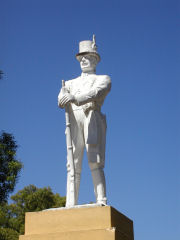
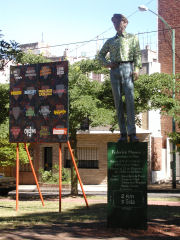
It was a day for “street food,” and for a whopping 2.40 pesos, I tucked into a glass of freshly squeezed orange juice (a very commonly available drink here, there are vendors all over the city with carts packed with bags of oranges and a citrus juicer bolted to the top), a couple of delicious homemade empanadas (egg, potato, peas, and green onion), and a nicely made tarta frita (a big round puff of fried dough).
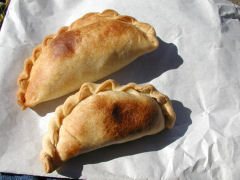
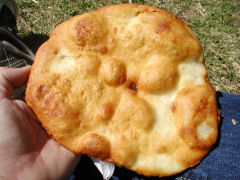
[…] I had the option of two different streets that fit my criteria of being named after famous dates in local history. I had plenty of energy after my wander along Jujuy, so I decided to take on the longer of the two, 24 de Noviembre, a 24 block primarily residential street that begins at Parque Patricios and stretches back through the Parque Patricios zone, into San Cristobal, and finally into Once, ending at Av. Rivadavia right off the back end of the Once train and bus station. There unfortunately isn’t a huge amount to say about the street itself, as it really is a predominately residential street, and one with minimally interesting architecture. Towards the southern end, in Patricios and Cristobal, most of the houses are smaller, two-story affairs, and a mix of blocky, flat-roofed buildings built mostly around the 1920s, to strips of more modern row-houses, probably built in the 1960s. There are scattered small warehouses, a few schools and churches, and the usual sort of neighborhood coffee shops or takeout lunch counters. November 24, 1849 – Governor Juan Manuel de Rosas of the Province of Buenos Aires signs an agreement with the British to end the blockade of the Rio de la Plata. I haven’t been able to find out much about this, but it appears that it may have involved a joint British and French endeavor to block the port access to the river, in response to de Rosas prohibiting their access to navigating up the river, that was, after two years of conflict, settled by treaty. This will take a little more research… […]
[…] to have had a street named after it. The street runs from the barrio of Parque Patricios, nearly at the park itself, right into the heart of barrio Constitución, in fact, ending right at the back of the main […]